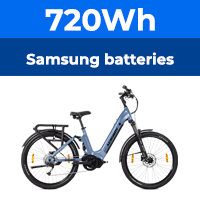Powabyke euromodel
- Thread starter gerryg
- Start date
@gerryg doesn't seem to have returned with any results after the controller repair resulted in constant full throttle.
I'm in a similar position with my old bike, my wife briefly used it 14 years ago but stopped cycling so I lent it to a friend, now it has been returned in a sorry state, battery completely dead and even when I string 3 car batteries together to apply 36V the controller shows no signs of life, no battery level leds illuminate.
Its in good mechanical order so could be given away as a pedal only bike but I would like to know options for getting the electric assist working again, how can I check the hub motor? What options with the controller? I can get a set of cheap mobility gel battery for 3 x £15 .
I'm in a similar position with my old bike, my wife briefly used it 14 years ago but stopped cycling so I lent it to a friend, now it has been returned in a sorry state, battery completely dead and even when I string 3 car batteries together to apply 36V the controller shows no signs of life, no battery level leds illuminate.
Its in good mechanical order so could be given away as a pedal only bike but I would like to know options for getting the electric assist working again, how can I check the hub motor? What options with the controller? I can get a set of cheap mobility gel battery for 3 x £15 .
Test the motor by connecting a 12v battery directly to the two motor wires. If it works OK, chuck all the electrics and get any other standard Chinese brushed motor controller that can give 20 amps. You'll need a new throttle to go with the controller and you'll be very lucky to find a controller that has the pedal assist function, though if you search hard, they do exist.
IMHO, these bikes are extremely heavy with the standard batteries and not very pleasant to ride. If you're going to spend any money, you'd be better off spending it on something modern.
IMHO, these bikes are extremely heavy with the standard batteries and not very pleasant to ride. If you're going to spend any money, you'd be better off spending it on something modern.
Thanks I'll check that.
I agree it's not worth investing much but ii this the sort of thing?

and a thumb throttle about another 12 quid brings total spend to around £85, may be worth it, not sure. I don't like the idea of throwing it away.
Is the battery monitor likely to work with another controller, else can it be reused in any way?
I agree it's not worth investing much but ii this the sort of thing?

24V 36V 48V 350W 500W e-Bike Motor Brushed Controller For Electric Bike Scooter | eBay
Find many great new & used options and get the best deals for 24V 36V 48V 350W 500W e-Bike Motor Brushed Controller For Electric Bike Scooter at the best online prices at eBay! Free delivery for many products.
www.ebay.co.uk
and a thumb throttle about another 12 quid brings total spend to around £85, may be worth it, not sure. I don't like the idea of throwing it away.
Is the battery monitor likely to work with another controller, else can it be reused in any way?
I'm not sure I agree with absolutely all the advice given here to thread starter @gerryg. Also, I had a similar bike and went through a similar process, including replacing the MOSFETS, but it still didn't work.
Since @Openspaceman has joined the discussion, the advice given by @vfr400 is good, a lot of this comment will more-or-less repeat what he says. Once the battery and motor have been checked, testing the rest is very technical and not in my opinion likely to succeed. The next step is to replace all the electronics. I have done this on a brushed 24V bike. On yours you can't just replace the controller as the throttle (and brake sensors) works backwards compared with current usage and the battery level indicator or equivalent won't work.
You can buy a package which includes controller, throttle and indicator for £20. An ebay search for "ebike brushed controller and throttle 36v 250w" found several. Be careful about where and from whom you buy it though.
The brake switch(es) won't work and there won't be any Pedelec, but that IMHO is an advantage once you are used to a throttle. Brake switches aren't a legal requirement, and "Grandfathers' rights" apply to Pedelec on older bikes. See panel "UK Electric Bike Law Guide" at page bottom.
Lithium batteries are much better, but it wouldn't make sense to convert to those because of the cost. It's worth spending some money to get the bike working with the cheaper lead-acid batteries, but because of its "first generation" weight and styling it's not worth spending a lot - if you want lithium power it would be better to buy a another bike.
Where can you "a set of cheap mobility gel battery for 3 x £15"!!! I've not seen a set under about £90.
Since @Openspaceman has joined the discussion, the advice given by @vfr400 is good, a lot of this comment will more-or-less repeat what he says. Once the battery and motor have been checked, testing the rest is very technical and not in my opinion likely to succeed. The next step is to replace all the electronics. I have done this on a brushed 24V bike. On yours you can't just replace the controller as the throttle (and brake sensors) works backwards compared with current usage and the battery level indicator or equivalent won't work.
You can buy a package which includes controller, throttle and indicator for £20. An ebay search for "ebike brushed controller and throttle 36v 250w" found several. Be careful about where and from whom you buy it though.
The brake switch(es) won't work and there won't be any Pedelec, but that IMHO is an advantage once you are used to a throttle. Brake switches aren't a legal requirement, and "Grandfathers' rights" apply to Pedelec on older bikes. See panel "UK Electric Bike Law Guide" at page bottom.
Lithium batteries are much better, but it wouldn't make sense to convert to those because of the cost. It's worth spending some money to get the bike working with the cheaper lead-acid batteries, but because of its "first generation" weight and styling it's not worth spending a lot - if you want lithium power it would be better to buy a another bike.
Where can you "a set of cheap mobility gel battery for 3 x £15"!!! I've not seen a set under about £90.
Last edited:
That controller should work OK. Get the 500w one because they don't specify the current, and 500w controllers are normally around 20 amps, which is what you need. If you like the bike, it's pretty easy to upgrade to a lithium battery, but you need one that can continuously give what the controller allows, so about 25 amps, which excludes most of the cheaper ones. In other words, you can't just buy any 36v lithium batteryThanks I'll check that.
I agree it's not worth investing much but ii this the sort of thing?

24V 36V 48V 350W 500W e-Bike Motor Brushed Controller For Electric Bike Scooter | eBay
Find many great new & used options and get the best deals for 24V 36V 48V 350W 500W e-Bike Motor Brushed Controller For Electric Bike Scooter at the best online prices at eBay! Free delivery for many products.www.ebay.co.uk
and a thumb throttle about another 12 quid brings total spend to around £85, may be worth it, not sure. I don't like the idea of throwing it away.
Is the battery monitor likely to work with another controller, else can it be reused in any way?
Where can you "a set of cheap mobility gel battery for 3 x £15"!!! I've not seen a set under about £90.
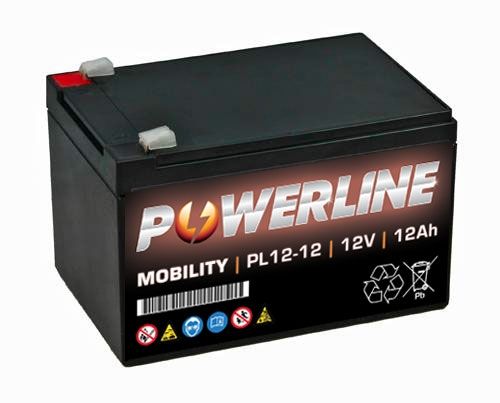
PL12-12 Powerline Mobility Battery 12V 12Ah
PL12-12 Powerline VRLA Mobility Battery Also Ideal for other traction applications like toy cars and electric motors. The Powerline battery brand name is fast becoming one of the best budget batteries on the market. With the highest power and performance at an affordable competitive price...
Thanks again for the advice
In principle what are the differences between lead acid and lithium performance?In other words, you can't just buy any 36v lithium battery
I get the impression that a 12Ah lead acid can only be taken to 50% depth of discharge whereas a lithium one can be discharged further, so a smaller lithium could be used for the same range?
@Openspaceman So far as the batteries in your link are concerned, they are perhaps a little cheaper than I have seen, but not much - they are £16 not £15, plus £8 delivery for one battery - there doesn't seem to be any way to find out how much it would be for three until you pay.
Last edited:
If you order three the checkout price including VAT and delivery is £55.92 as they only charge for one delivery, so £6 more than my rough figure.@Openspaceman So far as the batteries in your link are concerned, they are perhaps a little cheaper than I have seen, but not much - they are £16 not £15, plus £8 delivery for one battery - there doesn't seem to be any way to find out how much it would be for three until you pay.
That's a good price, however the originals were 12V 14Ah and the nearest equivalent is their 15Ah battery, the price of that even allowing for the extra capacity, isn't anything special. Perhaps higher capacity in the same physical size is bound to be more expensive.£55.92 as they only charge for one delivery
@Openspaceman Lithium batteries have a much longer life.
For other factors I've tried to compare my 24V 8Ah one with 3 Powabyke style lead acid batteries 3 x 12V 14Ah by multiplying everything by 36/24 and 14/8 to match the Powabyke's capacity. It's not really a fair comparison because it's an older type of cell than the currently ubiquitous 81650 type and probably lower tech. I also had to guess how much to take off the figures for the Lithium battery for the outer case with sockets etc.
For what it's worth, I estimate that the Pb/PB batteries are 1.4 times the size the Lithium would be and 1.9 times the weight.
For other factors I've tried to compare my 24V 8Ah one with 3 Powabyke style lead acid batteries 3 x 12V 14Ah by multiplying everything by 36/24 and 14/8 to match the Powabyke's capacity. It's not really a fair comparison because it's an older type of cell than the currently ubiquitous 81650 type and probably lower tech. I also had to guess how much to take off the figures for the Lithium battery for the outer case with sockets etc.
For what it's worth, I estimate that the Pb/PB batteries are 1.4 times the size the Lithium would be and 1.9 times the weight.
Last edited:
3 x 12v 12Ah SLA batteries weigh around 12kg and give around half the range of 12Ah lithium battery that would way around 3 - 4 kg, so the SLAs are 12 times the weight for the same range. Also they can't be left for extended periods without changing due to self discharge, and you only get about 250 charges from them compared with 500 for lithium.
@Openspaceman Here is the (rough) calcuation (rounded to one decimal place)
Capacity
Pb 36V x 14Ah = 504Wh
L 24V x 8Ah = 192Wh
So size and weight of L need multiplying by 504÷192 = 2.6
(Any error in estimating its size or weight will also be multiplied by 2.6)
Size
Pb 3 off 15.1 × 9.8 × 9.8 = 4351cc
L 2.6 times 7 x 7 x 24 = 3057cc
So size of Pb is 4351 / 3058 = 1.4 times as much as L
Weight
Pb 3 off 4.7 = 14.1Kg
L 2.6 times 3 = 7.8Kg (3Kg including case plug etc, at a guess 2.5 without)
So weight of Pb is 14.1 / 7.8 = 1.8 times as much as L
These figures pass the common-sense check and reflect my experience with the bicycles concerned in practice.
Capacity
Pb 36V x 14Ah = 504Wh
L 24V x 8Ah = 192Wh
So size and weight of L need multiplying by 504÷192 = 2.6
(Any error in estimating its size or weight will also be multiplied by 2.6)
Size
Pb 3 off 15.1 × 9.8 × 9.8 = 4351cc
L 2.6 times 7 x 7 x 24 = 3057cc
So size of Pb is 4351 / 3058 = 1.4 times as much as L
Weight
Pb 3 off 4.7 = 14.1Kg
L 2.6 times 3 = 7.8Kg (3Kg including case plug etc, at a guess 2.5 without)
So weight of Pb is 14.1 / 7.8 = 1.8 times as much as L
These figures pass the common-sense check and reflect my experience with the bicycles concerned in practice.
@Openspaceman
* The average of the figures given.
# The notes appear to suggest that this is for 100% discharge.
Shelf life is stated to be 20 years for Lithium, there's no figure for lead-acid, but we all know that a lead-acid battery soon becomes useless if left.
Figures from https://en.wikipedia.org/wiki/Comparison_of_commercial_battery_types
Battery chemistry from https://www.rbbattery.com/7-types-of-batteries-for-your-electric-bike/
"...combination of lithium polymer, iron phosphate, and manganese..."
I used the figures for Lithium Manganese Oxide because that seemed to be the nearest. Let me know if you know a more accurate data source or I have chosen the wrong oxide.
| Energy Density by Weight (Wh/Kg) | Energy Density by Volume (Wh/L) | Cycles (*) | Self Discharge Rate (%/month *) | |
| Lead-Acid | 40 | 75 | 71 | 11.5 |
| Lithium | 150 | 420 | 500 | 4.5 |
| Ratio | 3.75 | 5.5 | 7 | 0.4 |
# The notes appear to suggest that this is for 100% discharge.
Shelf life is stated to be 20 years for Lithium, there's no figure for lead-acid, but we all know that a lead-acid battery soon becomes useless if left.
Figures from https://en.wikipedia.org/wiki/Comparison_of_commercial_battery_types
Battery chemistry from https://www.rbbattery.com/7-types-of-batteries-for-your-electric-bike/
"...combination of lithium polymer, iron phosphate, and manganese..."
I used the figures for Lithium Manganese Oxide because that seemed to be the nearest. Let me know if you know a more accurate data source or I have chosen the wrong oxide.
Last edited:
# The notes appear to suggest that this is for 100% discharge.
Yet we know lead acid will lose life if taken below a DOD of 50%
Thanks both for the figures, I'm already sold on LiPo batteries but only have one on order to complement some PV panels.
I do have a cheap Aldi 4" angle grinder that uses their 40/20V lithium battery, it's impressive and 2.5Ah at the 40V use. Also a 1/2" impact wrench which is impressive too.
I have tested the hub motor and it spins freely with 12V.
Following up the advice to search for a throttle controller with battery indicator I saw this
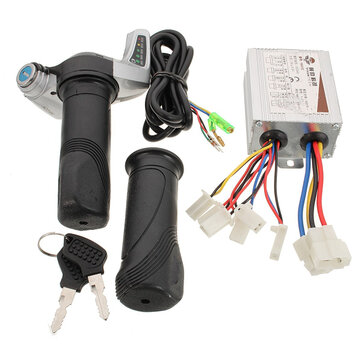
36V 500W Brushed Controller With Throttle Twist Grips 7/8 inch 22mm For Electric Scooter Bicycle
Only US$37.04, buy best 36V 500W Brushed Controller With Throttle Twist Grips 7/8 inch 22mm For Electric Scooter Bicycle sale online store at wholesale price.
So am I right in thinking the crank sensor to see that one is pedaling and the Hall effect spreed sensor with 4 magnets attached to the rear hub will not be used with this so it will not be limited to 12 or 15mph?
Is it likely any good?
I'll plump for the lesser Ah lead acid battery as I want to get going for the lowest price and will have to accept a lower range.
@Openspaceman I don't know anything about and have never used Banggood. I've no idea whether that item would be any good. See PM for more info.
I used this "24V 250w Brushed Controller Box FOR Electric Bicycle E-bike & Scooter" which I got off ebay, in a 24V 250W electric bicycle and it worked fine. This and the one you linked to haven't got crank or speed sensors, so pedalling or not has no effect on it and neither does speed. In practice it didn't exceed 15mph, I've read that that is to be expected. I imagine it is a limit in the electronics on the current or power supplied.
I think you are wise to stick with the cheaper lead-acid for this older bike. You can use your existing charger if you still have it and you won't have the hassle of designing the battery arrangement inside the box and wiring the cells.

I used this "24V 250w Brushed Controller Box FOR Electric Bicycle E-bike & Scooter" which I got off ebay, in a 24V 250W electric bicycle and it worked fine. This and the one you linked to haven't got crank or speed sensors, so pedalling or not has no effect on it and neither does speed. In practice it didn't exceed 15mph, I've read that that is to be expected. I imagine it is a limit in the electronics on the current or power supplied.
I think you are wise to stick with the cheaper lead-acid for this older bike. You can use your existing charger if you still have it and you won't have the hassle of designing the battery arrangement inside the box and wiring the cells.

Last edited:
Your "common sense" figures are way off and you're missing some vital knowledge. How much "experience" do you have - not much, it seems. Firstly, you can't empty an SLA battery. You only get about 6Ah out or a 12Ah one. Where can you find a 7.8kg 24v 8Ah lithium battery and why are you using that instead of a 36v 14Ah one? The average 500wh lithium battery weighs about 3.5 kg with the case. The cells weigh about 49g each, and there would be 40 or 50 in a typical ebike battery, so the actual cell-pack would be 2kg to 2.5kg. I think you need to do a bit more research about ebike batteries before you publish figures that are so misleading.@Openspaceman Here is the (rough) calcuation (rounded to one decimal place)
Capacity
Pb 36V x 14Ah = 504Wh
L 24V x 8Ah = 192Wh
So size and weight of L need multiplying by 504÷192 = 2.6
(Any error in estimating its size or weight will also be multiplied by 2.6)
Size
Pb 3 off 15.1 × 9.8 × 9.8 = 4351cc
L 2.6 times 7 x 7 x 24 = 3057cc
So size of Pb is 4351 / 3058 = 1.4 times as much as L
Weight
Pb 3 off 4.7 = 14.1Kg
L 2.6 times 3 = 7.8Kg (3Kg including case plug etc, at a guess 2.5 without)
So weight of Pb is 14.1 / 7.8 = 1.8 times as much as L
These figures pass the common-sense check and reflect my experience with the bicycles concerned in practice.
This 36v 14Ah lithium battery weighs 1.85kg :
Get a half width or thumb throttle. Full width ones tend to break when you hit a bump at full throttle because the stops are only thin plastic. Once the stop is broken, you can't get zero throttle anymore, and if you use your brake to stop the bike, you'll burn out the controller and/or the motor unless you have working brake switches. Even then, the bike will go as soon as you let go of the brake. That doesn't happen with half-width or thumb throttles because you don't have your weight on them while operating them.
I think they are in the right direction.
I mentioned the depth of discharge thing, do the Ah figures for lithium ion quote the realistic the energy you can get out before the battery management system cut off?
So if your 50% DOD means a lead acid 12Ah battery only delivers 6Ah to 50% dod and this makes it equivalent to a 6Ah lithium ion battery that is a greater price difference.
In my case I shall have to stick with lead acid at 1/3 of the price of the battery you quoted because the bike is not worth spending that much on, much as I like it.
I mentioned the depth of discharge thing, do the Ah figures for lithium ion quote the realistic the energy you can get out before the battery management system cut off?
So if your 50% DOD means a lead acid 12Ah battery only delivers 6Ah to 50% dod and this makes it equivalent to a 6Ah lithium ion battery that is a greater price difference.
In my case I shall have to stick with lead acid at 1/3 of the price of the battery you quoted because the bike is not worth spending that much on, much as I like it.
Related Articles
-
 MTF Enterprises announces acquisition of EMU Electric Bikes
MTF Enterprises announces acquisition of EMU Electric Bikes- Started by: Pedelecs
-
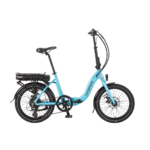 Wisper 806T folding bike wins Which? ‘Best Buy’
Wisper 806T folding bike wins Which? ‘Best Buy’- Started by: Pedelecs
-
 Sustrans calls for protected cycle lanes
Sustrans calls for protected cycle lanes- Started by: Pedelecs
-
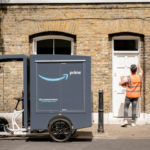 Amazon launch their first UK e-cargo micromobility hub
Amazon launch their first UK e-cargo micromobility hub- Started by: Pedelecs


